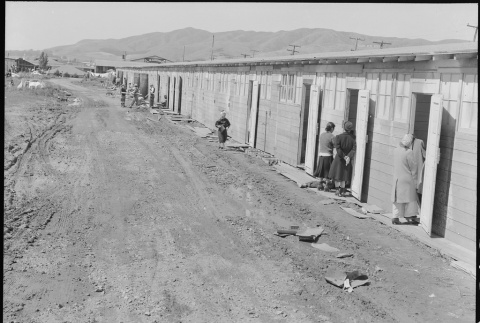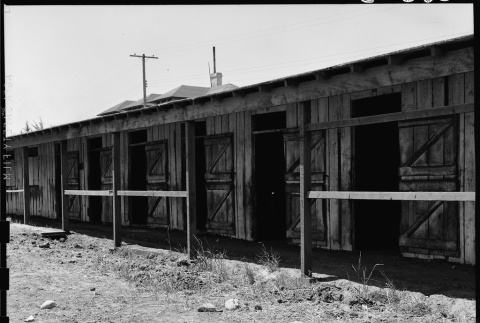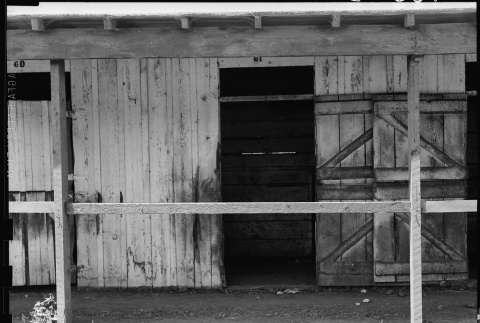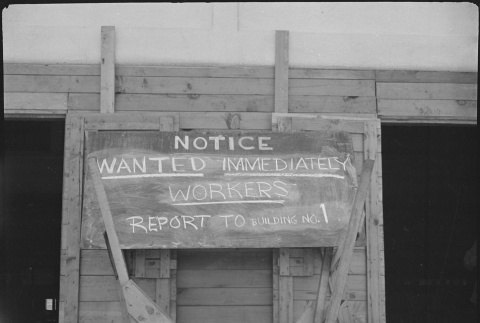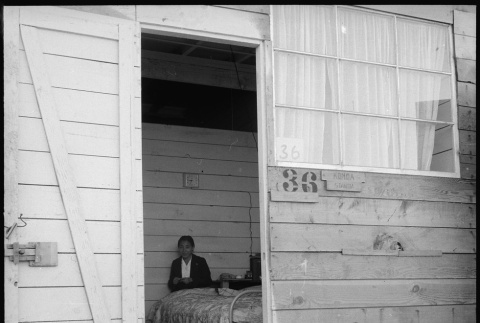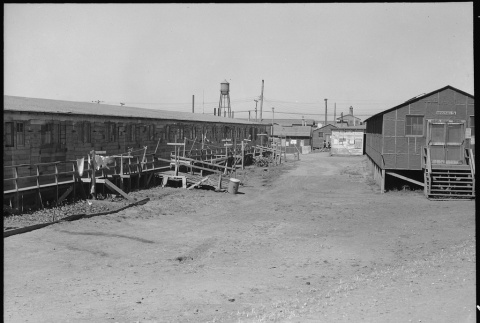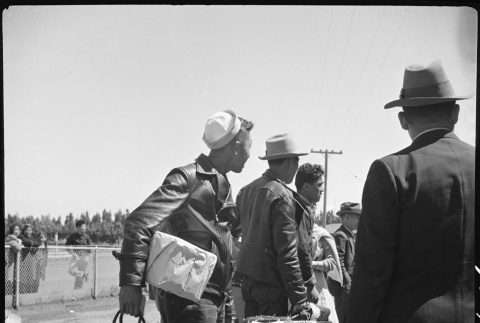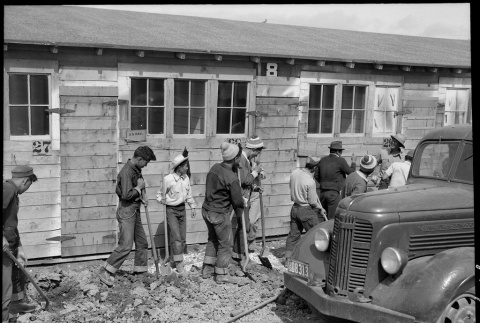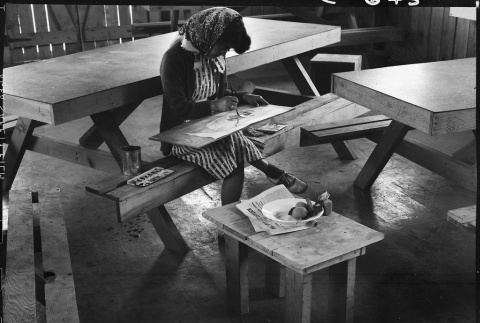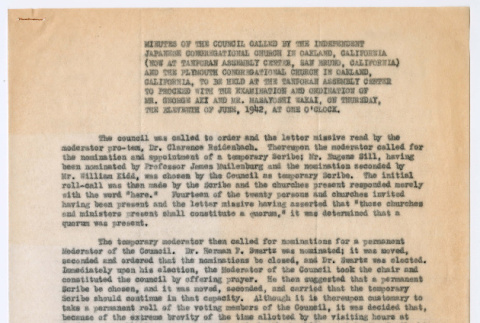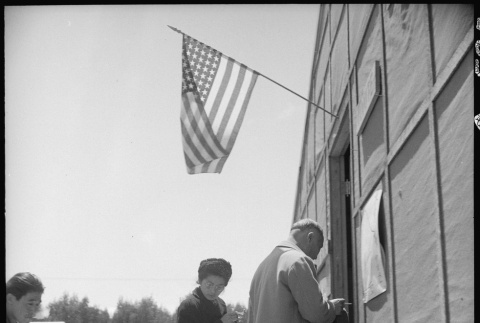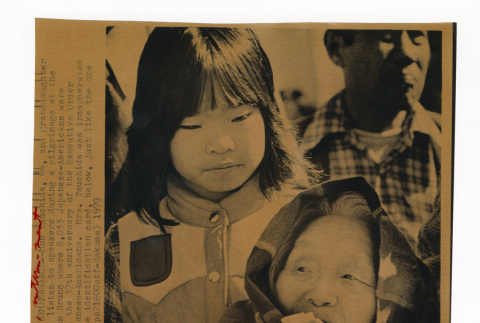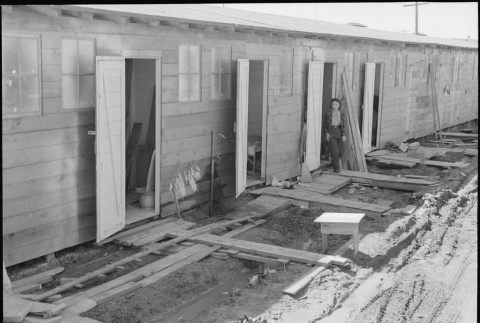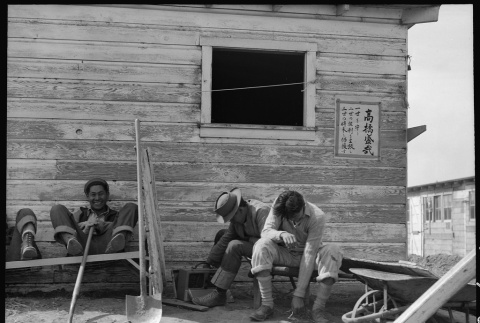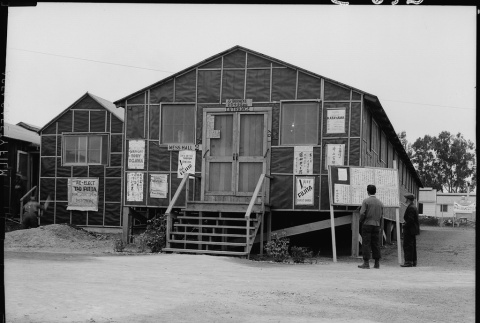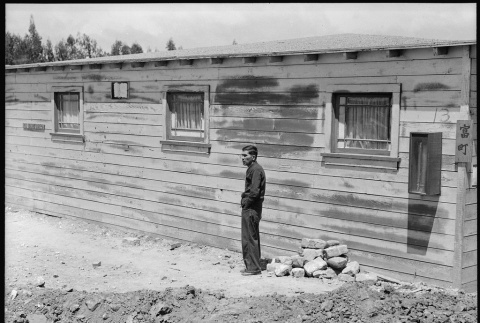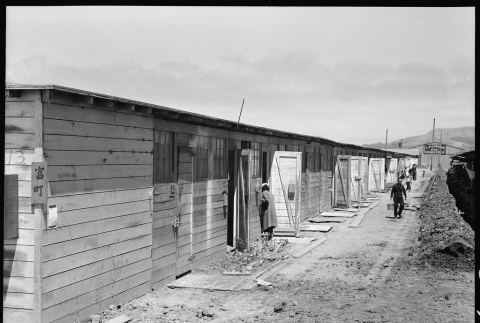156 items
156 items

img
Japanese Americans carving wood (ddr-densho-151-338)
Original caption: San Bruno, California. Father and son while away the hours carving small wooden animals for the children in front of their home in the barracks. They have been living at the Assembly center for approximately two weeks.

img
Remodeled horse stalls (ddr-densho-151-59)
Original WRA caption: San Bruno, California. This center is a converted race track. Here are shown what were horsestalls remodeled into living quarters for families. Photograph was made at noon on the third day after the center had been opened.

img
Preschool class (ddr-densho-151-331)
Original caption: San Bruno, California. Pre-school evacuee children leaving the building for recess at this assembly center. There are about 25 children enrolled with six volunteer student teachers being trained by a Mills College graduate, all of Japanese ancestry.

img
Horse stalls at Tanforan Assembly Center (ddr-densho-151-30)
Original WRA caption: San Bruno, California. Near view of horse-stall, left from the days when what is now Tanforan Assembly Center, was the famous Tanforan Race Track. Most of these stalls have been converted into family living quarters for Japanese.
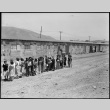
img
Japanese Americans in mess hall line (ddr-densho-151-44)
Original WRA caption: San Bruno, California. View of the Tanforan Assembly Center, showing a type of barrack peculiar to the center. Also shown in part of a line-up of evacuees waiting for places in the mess hall for their noon meal.
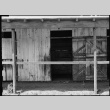
img
Horse stall at the Tanforan Assembly Center (ddr-densho-151-20)
Original WRA caption: San Bruno, California. A near- view of a horse stall left from days when what is now Tanforan Assembly center, was the famous Tanforan Race Track. Most of these stalls have been converted into family living quarters for evacuated Japanese.

img
"Help wanted" sign (ddr-densho-151-229)
Original caption: San Bruno, California. "Help Wanted" sign displayed for newly arrived evacuees. There was much work to be done since the center was opened on the previous day. Three weeks later there were 8,000 persons of Japanese ancestry in this center.
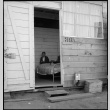
img
Japanese American inside barracks (ddr-densho-151-50)
Original WRA caption: San Bruno, California. A close-up of an entrance of a family apartment. Note that the windows in this unit have been enlarged. Five people occupy two small rooms, the inner one of which is without outside door or windows.
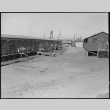
img
View of barracks and mess hall (ddr-densho-151-345)
Original caption: San Bruno, California. Another view of barracks at the Tanforan Assembly center, after approximately six weeks of occupancy. The building on the right is one of the eighteen such mess halls which, together, accommodate approximately 8,000 persons for three meals each day.
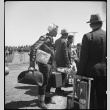
img
Japanese Americans arriving at Tanforan (ddr-densho-151-162)
Original caption: San Bruno, California. Evacuees of Japanese ancestry have just arrived at this Assembly center. They have been registered and are now awaiting a guide to show them to their place in the barracks. Later they will be transferred to War Relocation Authority centers.
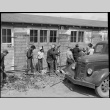
img
Japanese American workers digging a ditch (ddr-densho-151-342)
Original caption: San Bruno, California. Maintenance work, repair and construction is done by volunteer evacuee workers. The wages are $8.00 per month for 48 hours per week. This gang of boys and young men are digging a drainage tank along the front of one of the barracks.

img
Japanese American painting (ddr-densho-151-465)
Original caption: San Bruno, California. An art school wall has been established in this Assembly center with large enrollment and a well trained, experienced Japanese staff under the leadership of Professor Chiura Obata of the University of California. This photograph shows a student in Still Life class painting a free water color.
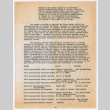
doc
Minutes of the council called by the independent Japanese Congregational Church, June 11, 1942 (ddr-densho-498-28)
Minutes of the council called by the Independent Japanese Congregational Church in Oakland, California (now at Tanforan Assembly Center, San Bruno, California) and the Plymoth Congregational Church in Oakland, California, to be held at the Tanforan Assembly Center to proceed with the examination and ordination of Mr. George Aki and Mr. Masayoshi Wakai, on June 11, …

img
Japanese Americans preparing to vote (ddr-densho-151-334)
Original caption: San Bruno, California. Entering Recreational Hall where election is being held for Councilman. A general election for five members of the Tanforan Assembly Center Advisory Council is being held on this day. The Issei have never been able to vote before because of American naturalization laws.
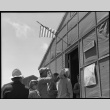
img
Japanese Americans waiting in line to vote (ddr-densho-151-349)
Original caption: San Bruno, California. Entering Recreational Hall where election is being held for Councilmen. A general election for five members of the Tanforan Assembly center Advisory Council is being held on this day. The Issei have never been able to vote before because of American naturalization laws.
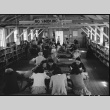
img
Japanese Americans reading in library (ddr-densho-151-353)
Original caption: San Bruno, California. A barrack building at this assembly center has been reserved for the library which has just been established with a trained librarian of Japanese ancestry in charge. All books and magazines have been donated and the shelves were made from scrap lumber by the evacuees.
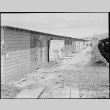
img
View of barracks (ddr-densho-151-357)
Original caption: San Bruno, California. Shown here is one type of barracks for family use. These were formerly the stalls for race horses. Each family is assigned to two small rooms, the inner one with no outside door nor window. The center has been in operation about six weeks. 8,000 evacuees are now assembled here.
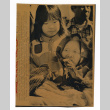
img
Mon Tsuchida and granddaughter Leonora during a pilgrimage to the site of Tanforan Assembly Center (ddr-csujad-52-47)
Caption next to image reads, "DAY OF REMEMBRANCE--Mon Tsuchida, 84, and granddaughter Leonora, 10, both from San Bruno, Calif. listen to speakers during a pilgrimage at the site of the old Tanforan racetrack in San Bruno where 8,033 Japanese-Americans were incarcerated during WWII. Monday marked the 37th anniversary of the Executive Order 9066 which incarcerated over …
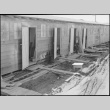
img
Assembly center barracks (ddr-densho-151-19)
Original WRA caption: Tanforan Assembly center, San Bruno, California. Barracks for family living quarters. Each door enters into a family unit of two small rooms. Tanforan assembly center was opened two days before the photograph was made. On the first day there had been a heavy rain. When a family has arrived here, first step of …

img
Japanese American workers resting in shade (ddr-densho-151-343)
Original caption: San Bruno, California. Time out for some of the boys on the Work Corps. All maintenance work, repair and construction is done by volunteer evacuee workers. The wages are $8.00 per month for 48 hours a week. This gang of boys and young men are digging a drainage tank along one of the barracks.
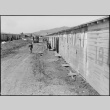
img
Assembly center barracks (ddr-densho-151-25)
Original WRA caption: San Bruno, California. Barracks for family living quarters. Each door enters into a family unit of two small rooms. Tanforan Center was opened two days before this photo was made. The truck seen coming down the dirt road is bringing bed-rolls and baggage to evacuees who have just arrived and are occupying these …
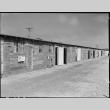
img
View of barracks (ddr-densho-151-346)
Original caption: San Bruno, California. Shown here is one type of barracks for family use. These were formerly the stalls for race horses. Each family is assigned to two small rooms, the inner one with no outside door nor window. The center has been in operation for about six weeks. 8,000 evacuees are now assembled here.
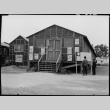
img
Mess hall (ddr-densho-151-358)
Original caption: San Bruno, California. One of eighteen mess halls plastered with all manner of locally devised posters advertising the qualifications of the various candidates for office in the forthcoming election. Three candidates have been nominated in each of the five precincts from which one from each precinct will be elected a member of the Advisory …
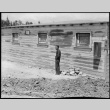
img
Japanese American next to barracks (ddr-densho-151-352)
Original caption: San Bruno, California. Many evacuees suffer from lack of their accustomed activity. The attitude of the man shown in this photograph is typical of the residents in assembly centers, and because there is not much to do and not enough work available, they mill around, they visit, they stroll and they linger to while …
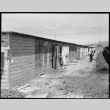
img
View of barracks (ddr-densho-151-344)
Original caption: San Bruno, California. This scene shows one type of barracks for family use. These were formerly the stalls for race horses. Each family is assigned to two small rooms, the inner one, of which, has no outside door nor window. The center has been in operation about six weeks and 8,000 persons of Japanese …

